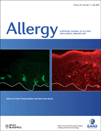IL-5 expression and release from human CD34 cells in vitro; ex vivo evidence from cases of asthma and Churg–Strauss syndrome
Edited by: Marc Humbert
Abstract
To cite this article: Bossios A, Sjöstrand M, Dahlborn A-K, Samitas K, Malmhäll C, Gaga M, Lötvall J. IL-5 expression and release from human CD34 cells in vitro; ex vivo evidence from cases of asthma and Churg–Strauss syndrome. Allergy 2010; 65: 831–839.
Background: Eosinophils develop from hematopoietic CD34+ progenitor cells in the bone marrow (BM) under the influence of Interleukin-5 (IL-5). The primary source of IL-5 is T-lymphocytes, although other sources may exist. The aims of this study were to determine whether CD34+ cells from human peripheral blood (PB) and BM have the capacity to produce IL-5 when stimulated in vitro, and secondly, whether an elevated number of IL-5-producing CD34+ cells can be found in situ in ongoing eosinophilic disease.
Methods: CD34+ cells from PB and BM were stimulated in vitro, and IL-5 production and release was assessed by ELISA, ELISPOT, flow cytometry and immunocytochemistry. Blood and BM from a patient with Churg–Strauss syndrome were analyzed by flow cytometry for CD34+/IL-5+ cells, and immunohistochemical staining of CD34+/IL-5+ cells in bronchial biopsies from an asthmatic patient was performed.
Results: Both PB and BM CD34+ cells can produce and release IL-5 when stimulated in vitro. In the Churg–Strauss patient, IL-5-producing CD34+ cells were found in PB and BM. Oral glucocorticoid treatment markedly decreased the number of IL-5-positive CD34 cells in the BM. CD34+/IL-5+ cells were present in a patient with asthma.
Conclusion: CD34+ cells in blood and BM are capable of producing IL-5 both in vitro and in vivo in humans, arguing that these cells may have the capacity to contribute to eosinophilic inflammation. Consequently, targeting CD34+ progenitor cells that produce and release IL-5 may be effective in reducing the mobilization of eosinophil lineage-committed cells in eosinophilic-driven diseases.




